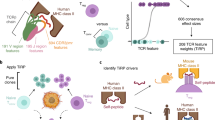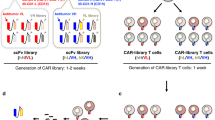Abstract
The specificity of cytolytic T lymphocytes (CTL) differs from that of B lymphocytes insofar as they exhibit a marked preference for recognition of major histocompatibility complex (MHC) encoded cell surface antigens. In murine systems, this is reflected both in the high frequency of CTL which recognize H–2 alloantigens1–5 and also in the requirement for recognition of syngeneic H–2 antigens in conjunction with cellularly presented foreign antigens, so called MHC restricted recognition6–10. Various models for T-cell recognition have been proposed in an attempt to explain both this predisposition for MHC recognition and the basis for restricted recognition (reviewed in refs 10, 11). Most models have fallen into one of two general categoriesf those which attribute recognition to two independent combining sites on the T cell receptor(s), one specific for foreign antigens and one specific for MHC antigens; and those which accommodate recognition of both molecules using a single combining site which recognizes a neoantigenic determinant composed of a complex of both molecules. In order to understand the basis for determinant recognition, the specificity of individual clones of C57BL/6 CTL induced in response to a point mutation in the H–2Kb molecule has been analysed. Using a series of H–2Kb mutants as targets it was found that a single clone can recognize two or more mutants which, although different from each other with respect to the position of their amino acid substitutions, appear to have independently gained the same new determinant. This strongly suggests that CTL can respond to conformational nuances in self H–2 molecules as shared by these different Kb mutants. On this basis, it is proposed that MHC restricted recognition may represent the recognition of conformational alterations of self resulting from the interaction of MHC molecules and foreign antigens.
This is a preview of subscription content, access via your institution
Access options
Subscribe to this journal
Receive 51 print issues and online access
$199.00 per year
only $3.90 per issue
Buy this article
- Purchase on Springer Link
- Instant access to full article PDF
Prices may be subject to local taxes which are calculated during checkout
Similar content being viewed by others
References
Wilson, D. B., Blythe, J. & Nowell, P. C. J. exp. Med. 128, 1157–1181 (1968).
Bevan, M. J., Langman, R. E. & Cohn, M. Eur. J. Immun. 6, 150–156 (1976).
Lindhal, K. F. & Wilson, D. B. J. exp. Med. 145, 508–522 (1977).
Miller, R. G., Teh, H.-S., Harley, E. & Philipps, R. A. Immun. Rev. 35, 38–58 (1977).
MacDonald, H. R. et al. Immun. Rev. 51, 93–123 (1980).
Zinkernagel, R. M. & Doherty, P. C. Nature 248, 701–702 (1974).
Shearer, G. M. Eur. J. Immun. 4, 527–533 (1974).
Bevan, M. J. J. exp. Med. 142, 1349–1364 (1975).
Forman, J. J. exp. Med. 142, 403–418 (1975).
Zinkernagel, R. M. & Doherty, P. C. Adv. Immun. 27, 51–177 (1979).
Matzinger, P. Nature 292, 497–501 (1981).
Sherman, L. A. J. exp. Med. 151, 1386–1397 (1980).
Sherman, L. A. J. Immun. 127, 1259–1260 (1981).
Sherman, L. A. J. exp. Med. 155, 380 (1982).
Sherman, L. A. Isolation, Characterization and Utilization of T. Lymphocytes (eds Fathman, C. G. & Fitch, F.) (Academic, New York, in the press).
Nairn, R., Yamaga, K. & Nathenson, S. G. A. Rev. Genet. 14, 241–277 (1980).
Klein, J. Adv. Immun. 26, 55–146 (1978).
Melief, C. J. M., de Waal, L. P., van der Meulen, M. Y., Melvold, R. W. & Kohn, H. L. J. exp. Med. 151, 993–1013 (1980).
White, T. J., Ibrahimi, I. M. & Wilson, A. C. Nature 274, 92–94 (1978).
Ohno, S., Epplen, J. T. & Sutou, S. Hum. Genet. 58, 37–45 (1981).
Schrader, J. W., Cunningham, B. A. & Edelman, G. M. Proc. natn. Acad. Sci. U.S.A. 72, 5066–5070 (1975).
Senik, A., Demant, P. & Neauport-Sautes, C. J. Immun. 122, 1461–1467 (1979).
Zarling, D. A., Watson, A. & Bach, F. Scand. J. Immun. 8, 497–508 (1978).
Bubbers, E. J., Chen, S. & Lilly, F. J. exp. Med. 147, 340–351 (1978).
Honneycutt, P. J. & Gooding, L. R. Eur. J. Immun. 10, 363–370 (1980).
Blanden, R. V., Hapel, A. J., Doherty, P. C. & Zinkernagel, R. M. in Immunobiology of the Macrophage (ed. Nelson, D. S.) 367–400 (Academic, New York, 1976).
Braciale, T. J. Cell. Immun. 33, 423–436 (1977).
Doherty, P. C., Blanden, R. V. & Zinkernagel, R. M. Transplant. Rev. 29, 89–124 (1976).
Askonas, B. A. & Webster, R. G. Eur. J. Immun. 10, 151–156 (1980).
Effros, R. B., Doherty, P. C., Gerhard, W. & Bennink, J. J. exp. Med. 145, 557–568.
Braciale, T. J. J. exp. Med. 149, 856–869 (1979).
Ada, G. L. & Yap, K. L. Immunochemistry 14, 643–651 (1977).
Finberg, R., Burakoff, S., Cantor, H. & Benacerraf, B. Proc. natn. Acad. Sci. U.S.A. 75, 5145–5149 (1978).
von Boehmer, H. et al. Eur. J. Immun. 9, 592–597 (1979).
Sredni, B. & Schwartz, R. H. Nature 287, 855–857 (1980).
Braciale, T. J., Andrew, M. E. & Braciale, V. L. J. exp. Med. 153, 1371–1376 (1981).
Wagner, H. et al. Immun. Rev. 58, 95–129 (1981).
Author information
Authors and Affiliations
Rights and permissions
About this article
Cite this article
Sherman, L. Recognition of conformational determinants on H–2 by cytolytic T lymphocytes. Nature 297, 511–513 (1982). https://doi.org/10.1038/297511a0
Received:
Accepted:
Issue Date:
DOI: https://doi.org/10.1038/297511a0
This article is cited by
-
β 2 Microglobulin Expression in Normal Melanocytes, Nevocellular Nevi, and Malignant Melanomas
Journal of Investigative Dermatology (1989)
-
Structural analysis of HLA-A2.4 functional variant KNE. Implications for the mapping of HLA-A2-specific T-cell epitopes
Immunogenetics (1988)
-
Somatic cell variants of the murine major histocompatibility complex
Immunologic Research (1987)
-
T-cell recognition of antigen and the Ia molecule as a ternary complex
Nature (1986)
-
Antigen-major histocompatibility complex-T cell receptors: Inquiries into the immunologicalménage à trois
Immunologic Research (1986)
Comments
By submitting a comment you agree to abide by our Terms and Community Guidelines. If you find something abusive or that does not comply with our terms or guidelines please flag it as inappropriate.



